树脂传递模塑(RTM)工艺过程共102页文档
树脂传递模塑_RTM_工艺的发展及应用
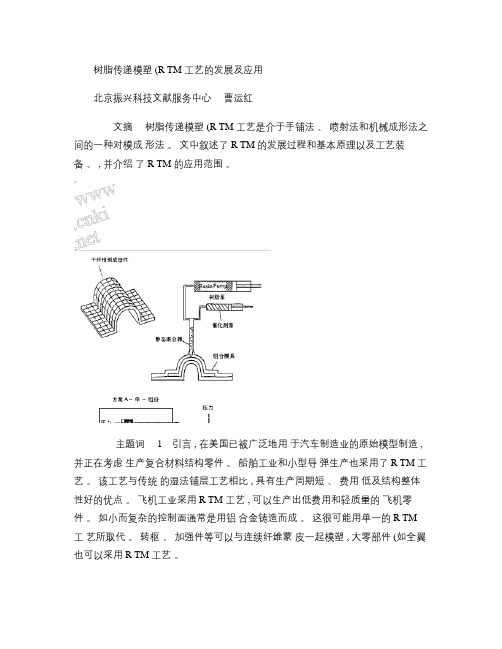
树脂传递模塑 (R TM 工艺的发展及应用北京振兴科技文献服务中心曹运红文摘树脂传递模塑 (R TM 工艺是介于手铺法、喷射法和机械成形法之间的一种对模成形法。
文中叙述了 R TM 的发展过程和基本原理以及工艺装备、 , 并介绍了 R TM 的应用范围。
主题词 1引言 , 在美国已被广泛地用于汽车制造业的原始模型制造 , 并正在考虑生产复合材料结构零件。
船舶工业和小型导弹生产也采用了 R TM 工艺。
该工艺与传统的湿法铺层工艺相比 , 具有生产周期短、费用低及结构整体性好的优点。
飞机工业采用 R TM 工艺 , 可以生产出低费用和轻质量的飞机零件。
如小而复杂的控制面通常是用铝合金铸造而成。
这很可能用单一的 R TM 工艺所取代。
转枢、加强件等可以与连续纤维蒙皮一起模塑 , 大零部件 (如全翼也可以采用 R TM 工艺。
R TM 工艺的起源 , 可以追溯到四十年代末期 , 最初是为适用飞机雷达天线罩成形而发展起来的。
经过 30年的发展 , 英国航空航天公司在采用 R TM 工艺生产高整体性和高价结构如雷达天线罩方面拥有相当的经验。
手铺成型和喷射成型具有投资少等优点 , 但对环境污染 (苯乙烯较严重。
近年来 ,欧美等国家限制大气中苯乙烯含量 , 人们的兴趣也转移到 R TM 工艺上来。
因 R TM 工艺的掘起已使欧美发达国家产生了很大的变。
2基本原理及工艺装备 2. 1基本原理图 1 R TM 工艺原理图R TM 工艺的基本原理是 :在一个闭式的模具内预置纤维增强预型件 , 再用低压 (小于 0. 69M Pa 将树脂系统注入模具内 , 使之浸透纤维增强预型件 , 然后固化成两面光洁的零件 , 如图 1、 2所示。
图 2 R TM 工艺简图2. 2 R TM 工艺装备美国壳牌发展公司用作 R TM 工艺的装备包括注射系统、电热式加热器加热的 P -20钢模具、液压机、温度控制系统、真空泵、压力容器。
RTM工艺简述及RTM模具制作过程
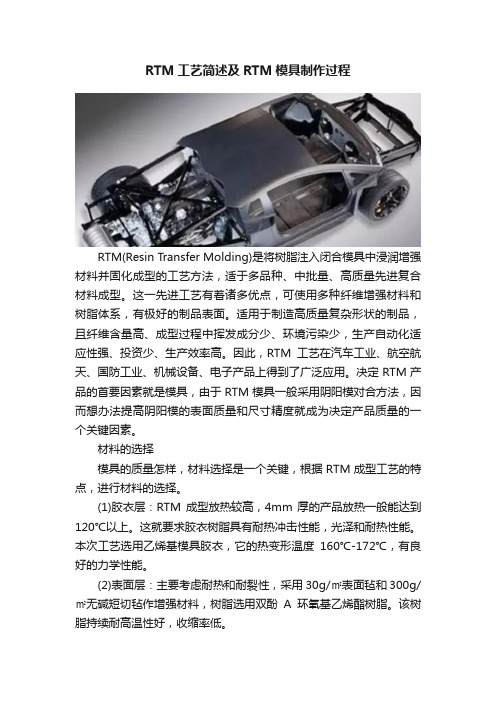
RTM工艺简述及RTM模具制作过程RTM(Resin Transfer Molding)是将树脂注入闭合模具中浸润增强材料并固化成型的工艺方法,适于多品种、中批量、高质量先进复合材料成型。
这一先进工艺有着诸多优点,可使用多种纤维增强材料和树脂体系,有极好的制品表面。
适用于制造高质量复杂形状的制品,且纤维含量高、成型过程中挥发成分少、环境污染少,生产自动化适应性强、投资少、生产效率高。
因此,RTM工艺在汽车工业、航空航天、国防工业、机械设备、电子产品上得到了广泛应用。
决定RTM产品的首要因素就是模具,由于RTM模具一般采用阴阳模对合方法,因而想办法提高阴阳模的表面质量和尺寸精度就成为决定产品质量的一个关键因素。
材料的选择模具的质量怎样,材料选择是一个关键,根据RTM成型工艺的特点,进行材料的选择。
(1)胶衣层:RTM成型放热较高,4mm厚的产品放热一般能达到120℃以上。
这就要求胶衣树脂具有耐热冲击性能,光泽和耐热性能。
本次工艺选用乙烯基模具胶衣,它的热变形温度160℃-172℃,有良好的力学性能。
(2)表面层:主要考虑耐热和耐裂性,采用30g/㎡表面毡和300g/㎡无碱短切毡作增强材料,树脂选用双酚A环氧基乙烯酯树脂。
该树脂持续耐高温性好,收缩率低。
(3)增强层:重视强度和收缩性,选用的增强材料为0.4的无碱布和300g/㎡无碱短切毡作为增强材料,采用零收缩树脂树脂为基体材料。
(4)加固层:增加模具的整体刚度,便于开合模操作,采用钢框架加固的方式。
原模的制作一直以来FRP模具的原模很多采用石膏、木材、水泥、石蜡等作为基材,采用手工制作的方法,用这些材料和制作工艺制作的母模表面很难达到A级表面,尺寸精度也无法控制、制作程序复杂、周期长、容易产生缺陷,平整度较差,只适合那些精度要求较低、表面质量要求不高的FRP模具制作。
如果采用上面的方法,根本无法达到RTM模型的制作要求。
为满足RTM模型的要求,可以采用块状可加工树脂为原料通过数控加工制作。
树脂传递模塑(RTM)工艺过程资料

充填速度对流动的影响
山东大学博士学位论文答辩
130 125 120 115 110
纤维束间距对流动的影响
4.6 4.4 4.2 R=2.0mm R=1.6mm R=1.2mm
Pressure (Pa)
105 100 95 90 85 80 75 70 2.2 2.4 2.6 2.8 3.0 3.2 3.4 3.6 3.8 4.0 4.2
山东大学博士学位论文答辩
Fiber Composites
山东大学博士学位论文答辩
课题来源
国家重点基础研究发展计划(973计划)项目: ——“先进聚合物基复合材料的多层次结构和
性能研究”
(批准号:2003CB615600) —— 01课题:复合体系的浸润、流变与检测 起止年月:2004年1月-2008年12月
3.3 束内与束间的树脂流场相互作用的 数值模拟流程
3.4 恒流速入口条件下的数值模拟 3.5 恒压入口条件下的数值模拟
山东大学博士学位论文答辩
3.1.1 控制方程
连续性方程
u x v y 0
动量方程 控 制 方 程
f 2 u 2 u p 1 u 1 u u u v 2 eff 2 f t f x y x y 2 x
C u C v C 0 t f x f y
山东大学博士学位论文答辩
把树脂在纤维预制体内的流动作为两相流 (树脂相和空气相)处理,在每个控制体内, 粘度和密度的表达式为: C 1 (1 C )2
C 1 (1 C) 2
流体体积函数的定义如下:
2
S ABFGD
2
2
试介绍树脂传递法(rtm)及该工艺过程的特点

试介绍树脂传递法(rtm)及该工艺过程的特点下载提示:该文档是本店铺精心编制而成的,希望大家下载后,能够帮助大家解决实际问题。
文档下载后可定制修改,请根据实际需要进行调整和使用,谢谢!本店铺为大家提供各种类型的实用资料,如教育随笔、日记赏析、句子摘抄、古诗大全、经典美文、话题作文、工作总结、词语解析、文案摘录、其他资料等等,想了解不同资料格式和写法,敬请关注!Download tips: This document is carefully compiled by this editor. I hope that after you download it, it can help you solve practical problems. The document can be customized and modified after downloading, please adjust and use it according to actual needs, thank you! In addition, this shop provides you with various types of practical materials, such as educational essays, diary appreciation, sentence excerpts, ancient poems, classic articles, topic composition, work summary, word parsing, copy excerpts, other materials and so on, want to know different data formats and writing methods, please pay attention!树脂传递法(RTM)是一种常用于复杂结构的树脂浸渍工艺。
rtm工艺技术
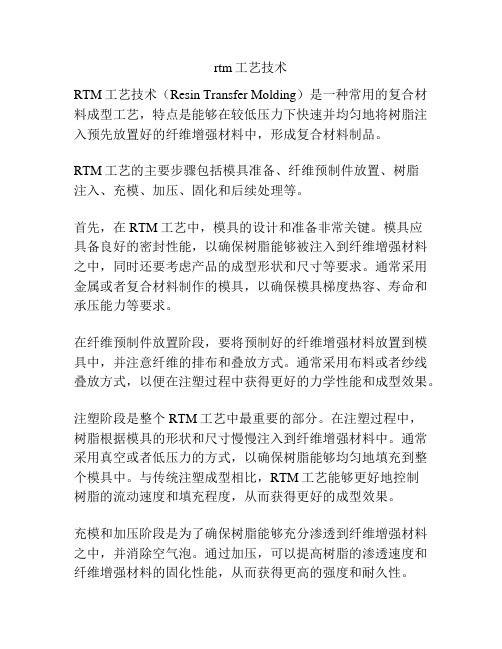
rtm工艺技术RTM工艺技术(Resin Transfer Molding)是一种常用的复合材料成型工艺,特点是能够在较低压力下快速并均匀地将树脂注入预先放置好的纤维增强材料中,形成复合材料制品。
RTM工艺的主要步骤包括模具准备、纤维预制件放置、树脂注入、充模、加压、固化和后续处理等。
首先,在RTM工艺中,模具的设计和准备非常关键。
模具应具备良好的密封性能,以确保树脂能够被注入到纤维增强材料之中,同时还要考虑产品的成型形状和尺寸等要求。
通常采用金属或者复合材料制作的模具,以确保模具梯度热容、寿命和承压能力等要求。
在纤维预制件放置阶段,要将预制好的纤维增强材料放置到模具中,并注意纤维的排布和叠放方式。
通常采用布料或者纱线叠放方式,以便在注塑过程中获得更好的力学性能和成型效果。
注塑阶段是整个RTM工艺中最重要的部分。
在注塑过程中,树脂根据模具的形状和尺寸慢慢注入到纤维增强材料中。
通常采用真空或者低压力的方式,以确保树脂能够均匀地填充到整个模具中。
与传统注塑成型相比,RTM工艺能够更好地控制树脂的流动速度和填充程度,从而获得更好的成型效果。
充模和加压阶段是为了确保树脂能够充分渗透到纤维增强材料之中,并消除空气泡。
通过加压,可以提高树脂的渗透速度和纤维增强材料的固化性能,从而获得更高的强度和耐久性。
固化阶段是将树脂完全固化,使纤维增强材料和树脂成为一个整体。
通常采用热固化或者光固化的方式,通过加热或者紫外线照射等方法,使树脂固化并与纤维增强材料牢固地结合在一起。
固化后的制品具有较高的强度、刚度和耐腐蚀性能,适用于各种工程应用。
最后,进行后续处理,如切割、修整、表面处理和涂装等,以获得符合要求的最终产品。
总之,RTM工艺技术是一种先进的复合材料成型工艺,具有成型效果好、成本低、产量高的优点。
通过合理选择纤维增强材料和树脂、优化模具设计、精确控制注塑和固化参数等,可以生产出符合要求的复合材料制品。
随着科学技术的不断发展,RTM工艺技术也将在航空航天、汽车工业、建筑业和体育用品等领域得到广泛应用。
rtm工艺流程
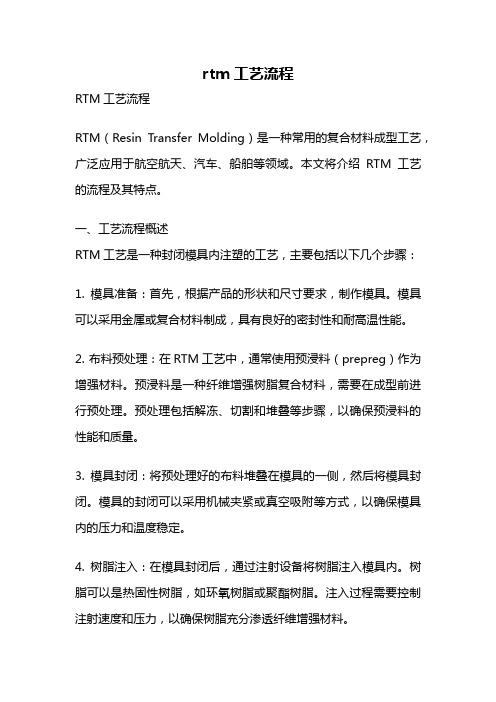
rtm工艺流程RTM工艺流程RTM(Resin Transfer Molding)是一种常用的复合材料成型工艺,广泛应用于航空航天、汽车、船舶等领域。
本文将介绍RTM工艺的流程及其特点。
一、工艺流程概述RTM工艺是一种封闭模具内注塑的工艺,主要包括以下几个步骤:1. 模具准备:首先,根据产品的形状和尺寸要求,制作模具。
模具可以采用金属或复合材料制成,具有良好的密封性和耐高温性能。
2. 布料预处理:在RTM工艺中,通常使用预浸料(prepreg)作为增强材料。
预浸料是一种纤维增强树脂复合材料,需要在成型前进行预处理。
预处理包括解冻、切割和堆叠等步骤,以确保预浸料的性能和质量。
3. 模具封闭:将预处理好的布料堆叠在模具的一侧,然后将模具封闭。
模具的封闭可以采用机械夹紧或真空吸附等方式,以确保模具内的压力和温度稳定。
4. 树脂注入:在模具封闭后,通过注射设备将树脂注入模具内。
树脂可以是热固性树脂,如环氧树脂或聚酯树脂。
注入过程需要控制注射速度和压力,以确保树脂充分渗透纤维增强材料。
5. 固化成型:树脂注入后,需要进行固化过程。
固化可以通过热固化或光固化等方式进行。
固化时间和温度需要根据树脂的性质和产品要求进行控制。
6. 模具开启:在树脂固化后,打开模具,取出成型件。
成型件具有优良的力学性能和表面质量。
二、RTM工艺的特点RTM工艺相比其他成型工艺具有以下特点:1. 成型件质量高:由于RTM工艺采用封闭模具,可以有效控制树脂的渗透和固化过程,从而获得高质量的成型件。
2. 复杂形状成型:RTM工艺适用于复杂形状的产品制造,可以满足各种工程要求。
3. 纤维含量高:RTM工艺可以实现高纤维含量的复合材料制造,提高产品的强度和刚度。
4. 自动化程度高:RTM工艺可以实现自动化生产,提高生产效率和一致性。
5. 环保节能:RTM工艺中的树脂可以回收再利用,减少了废料的产生,符合环保要求。
总结:RTM工艺是一种先进的复合材料成型工艺,具有高质量、适用于复杂形状、高纤维含量、自动化程度高和环保节能等特点。
rtm成型工艺过程

rtm成型工艺过程
RTM(Resin Transfer Molding)是一种常用的复合材料成型工艺,主要用于生产复材零部件。
RTM成型工艺包含以下几个步骤:
1.模具制备:根据产品的设计要求,制作适用于RTM成型的模具。
通常使用金属或者复合材料制造的模具。
2.面层制备:将预浸料(prepreg)或者无纺布等面层材料剪裁成所需形状和尺寸。
3.模具装备:将面层材料放置在模具的一侧,保持模具清洁。
4.预制:将需要使用的纤维束定位在模具中,并按照设计要求进行预配置,通常采用预定位工具如夹具等,以确保纤维束的定位精准。
5.闭模:将两半模具闭合,并确保模具密封。
通常采用安全和可控的方法进行模具闭合,以防止树脂泄漏。
6.树脂注入:在成型开始前,通过开启充注阀门,将树脂注入模具中。
注入时使用低压或者真空吸引树脂进入纤维束,以确保树脂充分浸润纤维。
7.充注:树脂在模具内浸润纤维的过程中,需要保持一定的注入压力和速度,以确保树脂充分填充整个模具。
8.固化:树脂在充注完成后开始固化。
根据树脂的性质和设计要求,可以通过提高温度、加热模具或者添加固化剂等方法来促进树脂的固化。
9.开模:待树脂完全固化后,打开模具,取出成型件。
10.修整:对成型件进行修整,如去除多余的材料、修整边缘等。
树脂传递模塑工艺
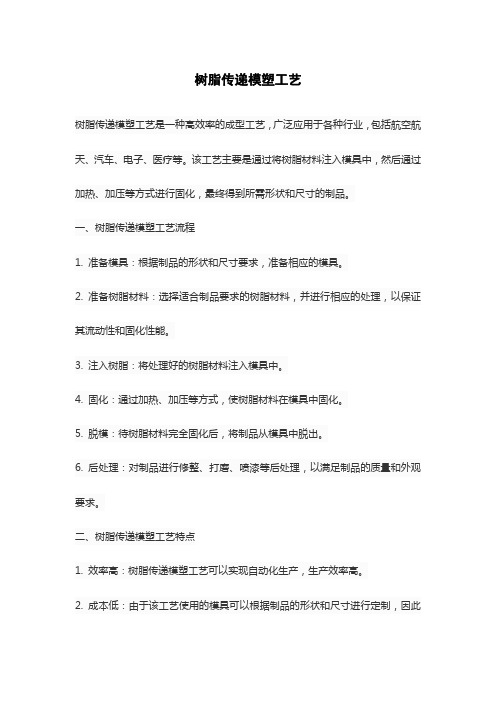
树脂传递模塑工艺树脂传递模塑工艺是一种高效率的成型工艺,广泛应用于各种行业,包括航空航天、汽车、电子、医疗等。
该工艺主要是通过将树脂材料注入模具中,然后通过加热、加压等方式进行固化,最终得到所需形状和尺寸的制品。
一、树脂传递模塑工艺流程1. 准备模具:根据制品的形状和尺寸要求,准备相应的模具。
2. 准备树脂材料:选择适合制品要求的树脂材料,并进行相应的处理,以保证其流动性和固化性能。
3. 注入树脂:将处理好的树脂材料注入模具中。
4. 固化:通过加热、加压等方式,使树脂材料在模具中固化。
5. 脱模:待树脂材料完全固化后,将制品从模具中脱出。
6. 后处理:对制品进行修整、打磨、喷漆等后处理,以满足制品的质量和外观要求。
二、树脂传递模塑工艺特点1. 效率高:树脂传递模塑工艺可以实现自动化生产,生产效率高。
2. 成本低:由于该工艺使用的模具可以根据制品的形状和尺寸进行定制,因此可以大大降低生产成本。
3. 适用范围广:树脂传递模塑工艺可以用于各种形状和尺寸的制品生产,适用范围广。
4. 环保:该工艺使用的树脂材料可以循环使用,对环境友好。
三、树脂传递模塑工艺的应用1. 航空航天领域:在航空航天领域,树脂传递模塑工艺被广泛应用于制造各种形状和尺寸的轻量化制品,如飞机零部件、卫星零部件等。
2. 汽车领域:在汽车领域,树脂传递模塑工艺被广泛应用于制造各种零部件,如汽车车门、汽车发动机罩等。
3. 电子领域:在电子领域,树脂传递模塑工艺被广泛应用于制造各种电子元器件,如电路板、电池等。
4. 医疗领域:在医疗领域,树脂传递模塑工艺被广泛应用于制造各种医疗器材,如医疗器械外壳、医疗容器等。
树脂传递模塑工艺是一种高效、环保、低成本的成型工艺,具有广泛的应用前景。
随着科技的不断发展,该工艺将会不断创新和完善,为各行各业的发展提供更加优质的技术支持。
rtm成型工艺流程
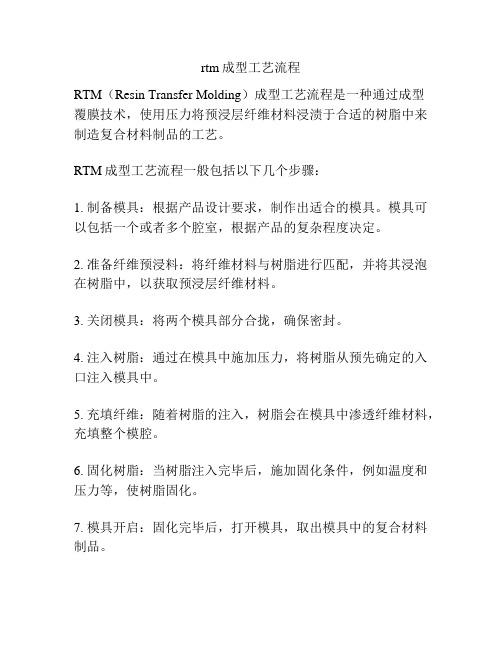
rtm成型工艺流程
RTM(Resin Transfer Molding)成型工艺流程是一种通过成型
覆膜技术,使用压力将预浸层纤维材料浸渍于合适的树脂中来制造复合材料制品的工艺。
RTM成型工艺流程一般包括以下几个步骤:
1. 制备模具:根据产品设计要求,制作出适合的模具。
模具可以包括一个或者多个腔室,根据产品的复杂程度决定。
2. 准备纤维预浸料:将纤维材料与树脂进行匹配,并将其浸泡在树脂中,以获取预浸层纤维材料。
3. 关闭模具:将两个模具部分合拢,确保密封。
4. 注入树脂:通过在模具中施加压力,将树脂从预先确定的入口注入模具中。
5. 充填纤维:随着树脂的注入,树脂会在模具中渗透纤维材料,充填整个模腔。
6. 固化树脂:当树脂注入完毕后,施加固化条件,例如温度和压力等,使树脂固化。
7. 模具开启:固化完毕后,打开模具,取出模具中的复合材料制品。
8. 整理和加工:对取出的复合材料制品进行必要的整理和加工,例如去除闪烁,修整边缘等。
RTM成型工艺可以生产具有较高性能和复杂形状的复合材料
制品。
由于该工艺的成本较低,制造周期较短,并且适用于大批量生产,因此在航空航天、汽车、建筑等领域得到了广泛应用。
rtm 工艺技术
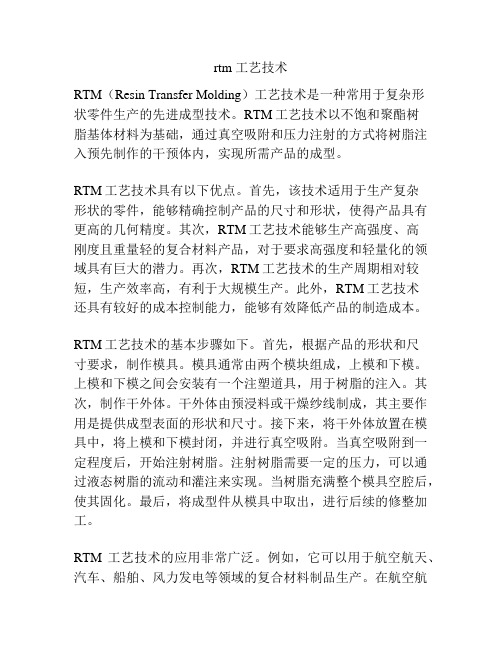
rtm 工艺技术RTM(Resin Transfer Molding)工艺技术是一种常用于复杂形状零件生产的先进成型技术。
RTM工艺技术以不饱和聚酯树脂基体材料为基础,通过真空吸附和压力注射的方式将树脂注入预先制作的干预体内,实现所需产品的成型。
RTM工艺技术具有以下优点。
首先,该技术适用于生产复杂形状的零件,能够精确控制产品的尺寸和形状,使得产品具有更高的几何精度。
其次,RTM工艺技术能够生产高强度、高刚度且重量轻的复合材料产品,对于要求高强度和轻量化的领域具有巨大的潜力。
再次,RTM工艺技术的生产周期相对较短,生产效率高,有利于大规模生产。
此外,RTM工艺技术还具有较好的成本控制能力,能够有效降低产品的制造成本。
RTM工艺技术的基本步骤如下。
首先,根据产品的形状和尺寸要求,制作模具。
模具通常由两个模块组成,上模和下模。
上模和下模之间会安装有一个注塑道具,用于树脂的注入。
其次,制作干外体。
干外体由预浸料或干燥纱线制成,其主要作用是提供成型表面的形状和尺寸。
接下来,将干外体放置在模具中,将上模和下模封闭,并进行真空吸附。
当真空吸附到一定程度后,开始注射树脂。
注射树脂需要一定的压力,可以通过液态树脂的流动和灌注来实现。
当树脂充满整个模具空腔后,使其固化。
最后,将成型件从模具中取出,进行后续的修整加工。
RTM工艺技术的应用非常广泛。
例如,它可以用于航空航天、汽车、船舶、风力发电等领域的复合材料制品生产。
在航空航天领域,复合材料产品具有高强度、高刚度、耐高温等特点,能够满足飞机零件对于性能要求的同时,减轻飞机自身的重量,提高燃油经济性和航空器的使用寿命。
在汽车领域,RTM工艺技术可以用于制作车身、底盘等零部件,使得汽车更轻、更稳定、更节能。
在船舶领域,RTM工艺技术可以制作船体、罩壳等结构件,提高船舶的承载能力和耐候性。
在风力发电领域,RTM工艺技术可以制作复合材料叶片,提高风力发电机组的效率。
总之,RTM工艺技术是一种先进的复合材料成型技术,通过树脂的注入和固化,可以生产出具有复杂形状、高强度、高刚度的复合材料产品。
轻型树脂传递模塑工艺(l-rtm)(Lightweight resin transfer molding process (l-rtm))
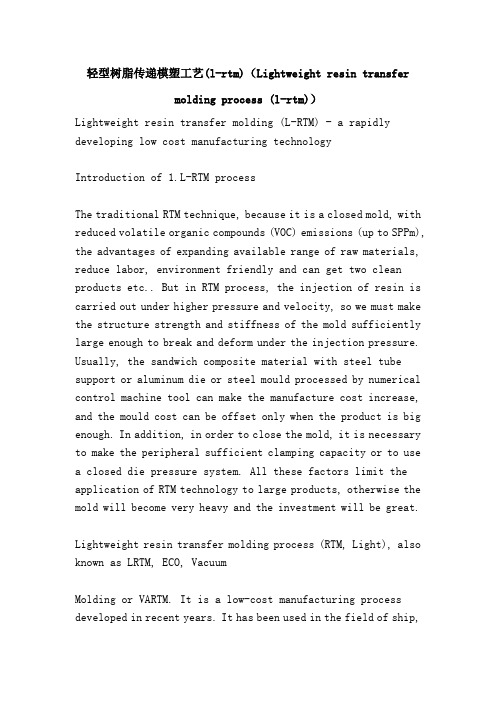
轻型树脂传递模塑工艺(l-rtm)(Lightweight resin transfermolding process (l-rtm))Lightweight resin transfer molding (L-RTM) - a rapidly developing low cost manufacturing technologyIntroduction of 1.L-RTM processThe traditional RTM technique, because it is a closed mold, with reduced volatile organic compounds (VOC) emissions (up to SPPm), the advantages of expanding available range of raw materials, reduce labor, environment friendly and can get two clean products etc.. But in RTM process, the injection of resin is carried out under higher pressure and velocity, so we must make the structure strength and stiffness of the mold sufficiently large enough to break and deform under the injection pressure. Usually, the sandwich composite material with steel tube support or aluminum die or steel mould processed by numerical control machine tool can make the manufacture cost increase, and the mould cost can be offset only when the product is big enough. In addition, in order to close the mold, it is necessary to make the peripheral sufficient clamping capacity or to use a closed die pressure system. All these factors limit the application of RTM technology to large products, otherwise the mold will become very heavy and the investment will be great.Lightweight resin transfer molding process (RTM, Light), also known as LRTM, ECO, VacuumMolding or VARTM. It is a low-cost manufacturing process developed in recent years. It has been used in the field of ship,automobile, industry and medical composite material more than RTM technology.The RTM Light process retains the die processing process of the RTM process, thus retaining almost all of the advantages of the RTM process. But the upper die for glass steel mould half rigid, thickness 6 8mm, usually do not need to use the steel reinforcement, the mold has a width of about 100mm by the rigid surrounding, double sealing belt constitutes an independent seal area, as long as a vacuum mold is closed and is very convenient and fast. Then the cavity is evacuated, and the resin is injected into the mold with the negative pressure in the mold and the lower injection pressure. The resin is infiltrated into the pre laid reinforcing fiber or preform. RTM - Light mold cost is low, and because the mold pressure reduction, its mold has close to the mold, it is easy to open mold from the process of transformation.The main equipment of RTM Light includes resin injection device, mold, vacuum pump and other auxiliary tools.2 light RTM compared with regular RTM(1) die;The mold is the biggest difference between the two processes. In the RTM investment, a considerable part of the cost is spent on the die and the clamping device because of the high injection pressure. This is not a good price for a product with little output. RTM process, mold life of up to 5000 or more, high production efficiency, suitable for an annual output of morethan 2000 products.The biggest advantage of RTM Light is the low cost of its mold production. The cost is only about half of the regular RTM mold, but the service life of the die is lower than that of the RTM mold. It is suitable for the products with an annual output of about 1000 pieces.The RTM Light process produces products that are larger in size than the traditional RTM, which is usually as small as a basketball cap, a length of 8m long hull (about 25m2), but this is not the ultimate limit of size. The product size is smaller than the basketball cap, the difficulty is to add fiber, and the product is greater than 8m, how to deal with the mold on the difficult.The disadvantage of glass fiber reinforced plastic mould is short service life of mould surface. In order to get good die life and product repeatability and dimensional accuracy, RTM -Both the Light and RTM processes must be of high quality and have an accurate cross section. In the composite molding process, the cost of surface requirements of the final product can reach 60% of the final product price. The composite mold can achieve the use of 500 times the surface quality of the car, and then the surface treatment of the mold. One way to increase life expectancy is to use a replaceable die surface(ex-changeablemoldSkins), such as the patent of JHm Technologies company, ZIPRTM technology,It can be used in RTM and RTM Light processes. Through the use of replaceable die surface to replace the vulnerable mold surface, thereby prolonging the life of the die and improving the quality of the die, the service life of the die can reach 8000, 10000 times. When the simultaneous use of several replaceable mold surface, due to the outside in the mold can be replaced directly on the mold surface coating and heating, thereby greatly improving the production efficiency.(2) injection pressure, flow rate and equipment;The injection pressure of RTM process is usually 0.1 0.4MPa, while the injection pressure of RTM Light process is not more than.1MPa, usually at 0.03-0.07MPa.The rate of resin injection varies with various factors such as resin viscosity, component size, fiber type and ply structure. The usual injection rate is 1.3 to 2 litres per minute.In order to prevent mold deformation or burst mode (especially in the position of the injection port), which requires a strict control of pressure. Injection equipment for the RTM Light process is usually equipped with a pressure feedback device that controls the pressure as a closed loop. RTM is also available in the standard equipment of a simple line pressure control design (mold protection system and a VMPC) and VMPC with POD electronic closed-loop system, can not lead to molddeformation and failure under the condition of using the original production equipment to get the best productivity.Equipment research is also developing toward low cost and multi use. The SSB injection equipment of Plastech adopts patented piston reforming precision metering pump. The minimum ratio of catalyst is up to 0.5%, which matches the industrial MPG (MouldPressureguard) the pump speed can be controlled by the machine itself. In 12 seconds and 15 seconds, the 1m2 reinforced material can be impregnated, and the wetting speed can be accurately controlled. Configure other options, also for hand gluing and brushing.(3) production efficiency and costRTM one Light process is a low-cost production technology. Compared with the traditional RTM technology, the die cost is low, and the complicated pressing device or pressure system is not needed, the investment is small, the operation is simple, and the manpower capital is saved, etc.. Compared with the opening process, it has the high precision of the product size, low porosity, production of styrene volatilization, environmental friendly, less waste materials (resin utilization rate of up to 95%), low rejection rate, high production efficiency.The injection pressure is low, the resin flow rate can not be accelerated to the optimum flow, before the RTM Light process the production speed of less than half of the RTM process, with each class 8 hours, for the use of the gel coat and non heatingmould process, RTM process in each class can produce 10 A 12 die, RTM-The Light process produces only 4 and 6 dies. For a 34 square foot product that needs to be heated and cured, the RTM process produces 40 molds per shift with the use of a hydraulic press, a heating die, and 5 replaceable dies. RTM in the same situation- Light process, can produce 20 die. But no water press is needed, and the mold price is also half lower.In recent years, through the improvement of mold design and process control, both production speed is approaching. Such as Xiraplas company in the use of RTM Light process alternative mold opening process, the workshop has become orderly, the use of the original 50 workers, and 3000m2 workshop area, making production increased by 25%. According to the company, production efficiency has been increased by 90% compared to the original mold opening process.(4) runner designThe flow design of the general RTM process is injected from the center and discharged from the periphery. But the RTM-Light process usually flows in from the perimeter and out of the center. We know that when the resin enters the mold cavity from the resin pipe and meets the fabric, the fabric will produce a counter pressure (resistance) to the resin. The magnitude of the reverse pressure is related to the permeability of thefabric, the viscosity of the resin, and the flow velocity of the resin, when the fabric and resin are selected,It is proportional to the flow velocity of the resin. Take an area of 3M2, thickness of 3mm products as an example, the general injection pressure is 0.05MPa, the injection time is 6min, the injection flow is 1.33L/min. If the injection from the center and maintain the flow unchanged, the anti pressure can be increased to more than 0.1MPa, resulting in the mold opening or mold phenomenon, and lead to resin flow forward out of control and the formation of dry spots and other issues. For this reason, the flow rate must be reduced, but this prolongs the injection time, so the injection from the center usually takes more than 6 minutes. When the surrounding resin injection, first into a gap about the surrounding flow 1mm almost no resistance, and then enter the fiber resin into the fiber increase due to pathway (from a point into a surrounding), relative resin in fabric flow slows down, back pressure decreases, the injection rate increase the injection time can be shortened. Tests show that for a 0.2m2 product, the time of injection from the periphery is 2.1 minutes, and the injection from the center to 9 minutes, the speed difference of four times. Of course, RTM process can also be injected from the surrounding resin, the pressure gradient is unchanged, but the highest point of the pressure from the original center point is moved to the periphery, which is beneficial to the deformation control of die, because the surrounding rigid die is better than that of the central area, but also on the periphery of the sealing requirements increased.The flow path design varies with the product, such as the 18mlong lamp post of Spectrayte company and the long runner. Brands's 6m2 floor, due to its asymmetrical structure, uses two outlets, each with a resin collector (Catchpot) at the center of each structure, with an injection time of 15 minutes. The Holland Royal Navy 13m2 hull manufacturing, due to larger products, using two diagonal arrangement of resin imports.(5) product accuracy, structure and otherThe size, viscosity, and repeatability of RTM and RTM Light products are affected by molding, resin, process control, and product curing. The product cross sectional accuracy is also affected by resin flow rate and injection pressure in the process. For the RTM process, when the mold is made according to the standard, without bending, the appropriate clamping device or press clamping, the parts of the dimensional accuracy repeatability is very good, the thickness deviation is not greater than 0.OlOmm. The RTM Light process usually has a certain deformation of the upper die, but the product size accuracy can also reach 0.020mm. Individual places are 4 0.030mm.Both RTM and RTM a Light process can suppress the sandwich material. The core can be made of balsa wood and foam. But the RTM process has a high injection pressure, limiting the use of low-density foam materials, the minimum density of foam is not less than 80Kg/m3, while RTM, Light and ZIPThe RTM process has a lower pressure, and the foam density he uses can be as small as 37Kg/m3. However, it is important to point out that the dimensional accuracy of core material meetsthe requirements of the mold in order to ensure the repeatability of the molding process and the quality of the product.The RTM and RTM Light processes also use preforms and inserts, which allow for high fiber volume products when using preforms.RTM-Light process can not gel, as long as the general release of wax, can release products. But do not release products such as RTM gel, more difficult.Compared with the die opening process, the investment of RTM Light is still relatively high, so it is necessary to consider the rationality of the cost of producing the necessary molds. In addition, the process is very professional and the daily maintenance task is heavy. It also affects the use of RTM Light for some manufacturers of hand ply composites.Compared to RTM, RTM Light has a low energy consumption, not too high on the mold rigidity requirement, but the viscosity of resin, resin and enhance the compatibility of materials, and the resin forward speeds demanding.3 light RTM process should pay attention to the problemRTM Light process is a highly specialized process, operators must be properly trained. If there is no reasonable fiber coating, good gas tightness and accurate mold installation, there is no consistent resin flow control, the product will be messy dry spots, radial bubbles, and resin enrichment and other issues. The following is a brief explanation of the relevantissues.(1) tightnessThe RTM Ligh process requires a higher level of detail, especially the tightness of the mold. The lower the vacuum of the vacuum trough used for the peripheral clamping, the better. The degree of vacuum in the lumen is generally controlled at about 15mm Hg. The periphery is clamped with a vacuum sealing groove and a flexible neoprene wing sealing ring (WingSeal profile) its bottom width is 20mm, the sealing ring joint should be vertical cut, with flexible adhesive glue, in order to ensure its elasticity. Outer ring and then 6mm wide silicone rubber edge.In the molding process, in addition to pay attention to the sealing of mold vacuum sealant, but also note the assembly of the mold, sealing ring and pipe connection, as well as the mold leakage caused by leakage. In fact, any seal or the entrance of the resin entrance, including the outlet of the vacuum zone, shall be checked strictly. A more hidden leak is due to cracks in the surface of the die panel, which are usually not found. The solution to this problem is that it is a very effective way to coat the outer surface of a mold with a resin that has been modified by a catalyst before it reaches the vacuum.Also, keep the cover clean and try not to clean it with solvent. The best release agent is free semi permanent release agent.(2) precise matching between upper and lower dies.The precise matching between the upper and lower dies contributes to the pressure balance in the cavity of the mold, and enables the resin to permeate evenly and helps to improve the quality of the products. Since the upper die is a semi rigid die, each die must be carefully calibrated.If the white spot appears continuously at the same location, this may be because the mold is closed inaccurate, resulting in inaccurate internal cavity, which led directly to the uneven thickness of the inner cavity. In this case, if the glass fiber layer is uniform, resin injection process flow is selective, it will choose the thickness (GAP) where relatively large, so in the region will lead to a relatively thin cavity of leukoplakia.Poor die positioning is an important cause of poor matching of dies. When the edge pin of the die is installed, the X and Y axes of the mold are naturally defined. If the location of the pin is not correct, it will cause unpredictable errors and change the injection characteristics.(3) reasonable paving and selection of raw materials,Due to the low pressure molding process on a RTM Light layer paving fabric requirements more stringent, laying unreasonable, especially the processing of the lap joint, will seriously affect the consistency of the resin flow, resulting in the lack of glue or resin products (dry spots) phenomenon.But with the help of glue fixed fabric in the layer, the layeris more smooth. But the spray and the resin must be good intermiscibility, spray too much or have a certain impact on the final performance of the product.Different fabrics and felt have a great influence on the process. It is necessary to use the enhanced material as much as possible. The resin flow rate of the O.c. closed felt or Hi Flow composite felt is twice as fast as that of the ordinary chopped felt.The appropriate resin system should be chosen according to the product requirements. Use low viscosity, low shrinkage resin as much as possible. Its standards are comparable to those required for vacuum resin diffusion processes.(4) surface crackCracks on the surface of the product will often be observed in the corner area. This is a common problem in the resin enrichment zone.This can also be traced back to the manufacture of the mold. If the 2.5 dies do not fit well with each other, a margin exceeding the expected thickness is produced. To solve this problem, in addition to the correction of the semi mold, the thickness of the glass can also be increased by adding additional glass fibers in these thicker areas to prevent cracks in the product.In the large flat area, cracks in the mold due to excessive thickness are found. This is due to the arbitrary increase in the speed at which the resin is injected. Injection speed toofast, it will make the mould cavity expansion, if the injection process is completed in a very short period of time. So, the cavity is no time to recover, so will lead to excessive resin mold crack. In extreme cases, the cracks on the surface of the mold can not be repaired.(5) overflow of resinIn order to receive the resin that is discharged before molding, many manufacturers feel the need to use a larger resin collector. This is the result of their lack of accurate control of mold filling. If the resin filling process is too fast, it is difficult to determine when to stop the injection. Because if you see the resin go to the resin collector and then stop the injection, then you'll see that too much of the resin will flow to the resin collector because the excess expansion mold has returned to its original size. To overcome this possibility, you can only replace a larger resin collector to prevent the spillage of the resin.The easy way to solve this problem is to calculate how much resin to use. But it is difficult to know exactly how much resin to use when molding large articles. Another method is to provide the operator with accurate pneumatic control to avoid the operator's blind judgment. The air pressure readings in the chamber provide more accurate mold filling information for operations, avoiding the need for larger resin receivers. Such a system ensures that the allowance of 10 to 100 milliliters is sufficient after each injection, which allows the resin to minimize waste and ensure an increase in profits.If there is a resin overflow in the vacuum zone at the edge of the mold, there are several reasons:Sealing of sealant is not goodWhen the sealant path is not in a horizontal position, will result in leakage of resin, in the mold on the panel if there is a convex part, it is necessary to ensure sufficient pressure on the part of the sealant that is completely sealed. A better method is to install a dynamic strip, this dynamic strip, in the edge of complex adaptive path on the sealing surface when the mold is closed this strip can be slightly expanded to seal.Improper placement of fibers in mouldsPlaced in the mold when the fiber is not fully sunburner or pruning, that cannot be placed in the fiber in the mould, and some fibers in the sealant path, which will directly lead to the leakage of resin, to do so before molding each time to carefully check the fiber layer.The injection pressure is too largeAnother common cause is the cause of leakage of resin sealant in the injection process, injection pressure in the pipeline is too large RTM Light mold is closed only by the action of atmospheric pressure, resin injection molding machine can produce more than the actual needs of the pressure, if there is no more sensitive and accurate pressure control, resin will leak into the vacuum zone, which will lead to the loss and mould around vacuum production failure.Loss of vacuum sealWhether it is a long-term or temporary edge vacuum loss, will lead to leakage of resin. Therefore, do not access several molds in the same vacuum system, as this will result in a reduction in the vacuum in the main vacuum zone.In fact, a simple automatic vacuum lock valve helps reduce the possibility of this vacuum loss.4 light RTM applicationsThere are not many reports about RTM Light technology and products in China, but the application development in foreign countries is very fast, and there are more than RTM application trends. At present, the common application areas are aerospace, military, transportation, construction, ships and energy, etc.. For example: the field of aerospace doors, fan blades, radome, aircraft engine hood: military field, torpedo shell tank, tubes and other areas; traffic light rail bus door, side panels, chassis, bumper, truck at the top of the baffle; the building area of street lamp pole, tubular wind generator hood decoration, doors, tables and chairs and the helmet; the field of ship hull, deck and other small boats.。
rtm成型工艺过程
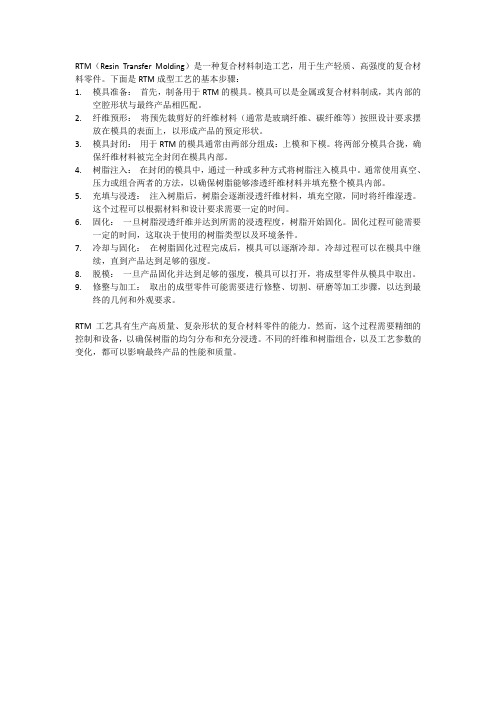
RTM(Resin Transfer Molding)是一种复合材料制造工艺,用于生产轻质、高强度的复合材料零件。
下面是RTM成型工艺的基本步骤:1.模具准备:首先,制备用于RTM的模具。
模具可以是金属或复合材料制成,其内部的空腔形状与最终产品相匹配。
2.纤维预形:将预先裁剪好的纤维材料(通常是玻璃纤维、碳纤维等)按照设计要求摆放在模具的表面上,以形成产品的预定形状。
3.模具封闭:用于RTM的模具通常由两部分组成:上模和下模。
将两部分模具合拢,确保纤维材料被完全封闭在模具内部。
4.树脂注入:在封闭的模具中,通过一种或多种方式将树脂注入模具中。
通常使用真空、压力或组合两者的方法,以确保树脂能够渗透纤维材料并填充整个模具内部。
5.充填与浸透:注入树脂后,树脂会逐渐浸透纤维材料,填充空隙,同时将纤维湿透。
这个过程可以根据材料和设计要求需要一定的时间。
6.固化:一旦树脂浸透纤维并达到所需的浸透程度,树脂开始固化。
固化过程可能需要一定的时间,这取决于使用的树脂类型以及环境条件。
7.冷却与固化:在树脂固化过程完成后,模具可以逐渐冷却。
冷却过程可以在模具中继续,直到产品达到足够的强度。
8.脱模:一旦产品固化并达到足够的强度,模具可以打开,将成型零件从模具中取出。
9.修整与加工:取出的成型零件可能需要进行修整、切割、研磨等加工步骤,以达到最终的几何和外观要求。
RTM工艺具有生产高质量、复杂形状的复合材料零件的能力。
然而,这个过程需要精细的控制和设备,以确保树脂的均匀分布和充分浸透。
不同的纤维和树脂组合,以及工艺参数的变化,都可以影响最终产品的性能和质量。
传递模塑工艺
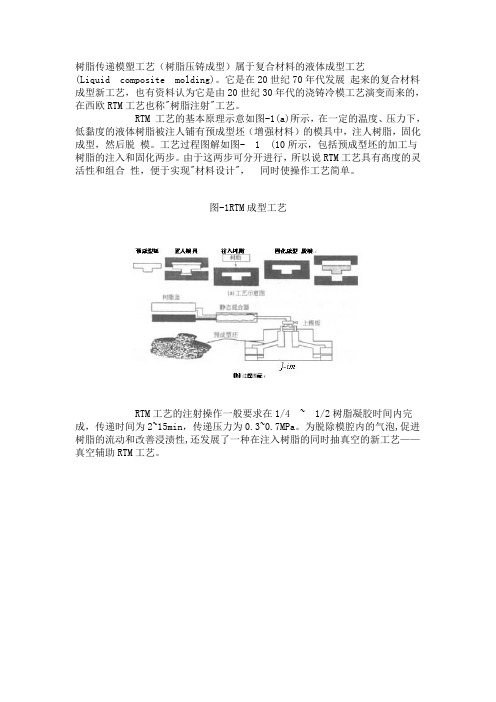
树脂传递模塑工艺(树脂压铸成型)属于复合材料的液体成型工艺
(Liquid composite molding)。
它是在20世纪70年代发展起来的复合材料成型新工艺,也有资料认为它是由20世纪30年代的浇铸冷模工艺演变而来的,在西欧RTM工艺也称"树脂注射"工艺。
RTM 工艺的基本原理示意如图-1(a)所示,在一定的温度、压力下,低黏度的液体树脂被注人铺有预成型坯(增强材料)的模具中,注人树脂,固化成型,然后脱模。
工艺过程图解如图- 1 (10所示,包括预成型坯的加工与树脂的注入和固化两步。
由于这两步可分开进行,所以说RTM工艺具有髙度的灵活性和组合性,便于实现"材料设计",同时使操作工艺简单。
图-1RTM成型工艺
RTM工艺的注射操作一般要求在1/4 ~ 1/2树脂凝胶时间内完成,传递时间为2~15min,传递压力为0.3~0.7MPa。
为脱除模腔内的气泡,促进树脂的流动和改善浸渍性,还发展了一种在注入树脂的同时抽真空的新工艺——真空辅助RTM工艺。
树脂传递模塑成型工艺
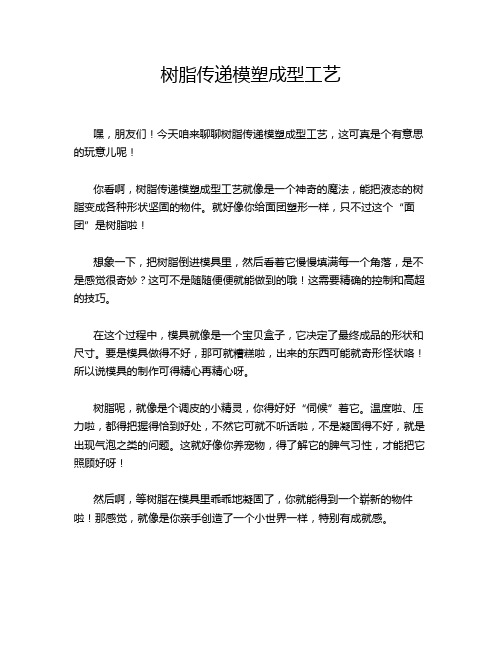
树脂传递模塑成型工艺嘿,朋友们!今天咱来聊聊树脂传递模塑成型工艺,这可真是个有意思的玩意儿呢!你看啊,树脂传递模塑成型工艺就像是一个神奇的魔法,能把液态的树脂变成各种形状坚固的物件。
就好像你给面团塑形一样,只不过这个“面团”是树脂啦!想象一下,把树脂倒进模具里,然后看着它慢慢填满每一个角落,是不是感觉很奇妙?这可不是随随便便就能做到的哦!这需要精确的控制和高超的技巧。
在这个过程中,模具就像是一个宝贝盒子,它决定了最终成品的形状和尺寸。
要是模具做得不好,那可就糟糕啦,出来的东西可能就奇形怪状咯!所以说模具的制作可得精心再精心呀。
树脂呢,就像是个调皮的小精灵,你得好好“伺候”着它。
温度啦、压力啦,都得把握得恰到好处,不然它可就不听话啦,不是凝固得不好,就是出现气泡之类的问题。
这就好像你养宠物,得了解它的脾气习性,才能把它照顾好呀!然后啊,等树脂在模具里乖乖地凝固了,你就能得到一个崭新的物件啦!那感觉,就像是你亲手创造了一个小世界一样,特别有成就感。
树脂传递模塑成型工艺的好处可不少呢!它能做出很复杂的形状,那些传统工艺很难做到的,它都能轻松搞定。
而且啊,成品的质量还特别好,坚固又耐用。
咱再说说它在实际生活中的应用吧,汽车零件、飞机部件,好多地方都有它的身影呢!你想想,那些精致的零件,可都是通过这个工艺制造出来的呀,多厉害!咱普通人虽然不会直接去用这个工艺做东西,但了解了解也挺有意思的呀,说不定哪天就能派上用场呢!比如说你突然想自己动手做个小玩意,这时候知道树脂传递模塑成型工艺不就派上用场啦?总之呢,树脂传递模塑成型工艺真的是个很了不起的工艺,它让我们的生活变得更加丰富多彩。
它就像一个默默奉献的幕后英雄,为我们制造出各种好用又好看的东西。
咱可得好好感谢这个工艺呀,不是吗?。
树脂传递模塑成型工艺及设备演示文稿

工 艺
对于短切纤维预成型坯,
如果纤维含量为(体
积)15%,则合模压力
约为49-78kPa。
7.1.2 RTM
第七章 树脂传递模塑成型工艺及设备
❖ RTM的成型周期可根据欲得成型制品所要求的产 量而适当设定。
由于一套模具的成型周期内树脂固化时间所占比 成 例很高,所以要充分考虑注入树脂的固化时间和固 型 化特性。 工 艺
第七章 树脂传递模塑成型工艺及设备
7.1 RTM
成 型
7.1 树脂传递模塑(RTM)成型
工 艺
工艺及设备与模具
及
设 备
液体成型工艺(Liquid Molding)
与
模
具
第七章 树脂传递模塑成型工艺及设备
7.1 RTM
7.1 树脂传递模塑(RTM)成型工艺及设备与模具
成
一、概述
型
工
二、RTM成型工艺
资少; 空隙率低(0~0.2%);
7.1.1 RTM
第七章 树脂传递模塑成型工艺及设备
纤维含量高; 便于使用计算机铺助设计(CAD)进行模具和产 品设计; 模塑的构件易于实现局部增强,可方便制造含 嵌件和局部加厚构件; 概 述 成型过程中散发的挥发性物质很少,有利于身 体健康和环境保护。
艺
及
三、流动性分析
设
备
四、RTM设备
与
模
具
7.1.1 RTM
第七章 树脂传递模塑成型工艺及设备
一、 RTM概述
树脂传递模塑(Resin Transfer Molding)
是从湿法铺层和注塑工艺中演变而来的一种新的复合材 料成型工艺。是介于手糊法、喷射法和模压成型之间的 一种对模成型法。
轻型树脂传递模塑工艺(l-rtm)(Lightweight resin transfer molding process (l-rtm))

轻型树脂传递模塑工艺(l-rtm)(Lightweight resin transfermolding process (l-rtm))Lightweight resin transfer molding (L-RTM) - a rapidly developing low cost manufacturing technologyIntroduction of 1.L-RTM processThe traditional RTM technique, because it is a closed mold, with reduced volatile organic compounds (VOC) emissions (up to SPPm), the advantages of expanding available range of raw materials, reduce labor, environment friendly and can get two clean products etc.. But in RTM process, the injection of resin is carried out under higher pressure and velocity, so we must make the structure strength and stiffness of the mold sufficiently large enough to break and deform under the injection pressure. Usually, the sandwich composite material with steel tube support or aluminum die or steel mould processed by numerical control machine tool can make the manufacture cost increase, and the mould cost can be offset only when the product is big enough. In addition, in order to close the mold, it is necessary to make the peripheral sufficient clamping capacity or to use a closed die pressure system. All these factors limit the application of RTM technology to large products, otherwise the mold will become very heavy and the investment will be great.Lightweight resin transfer molding process (RTM, Light), also known as LRTM, ECO, VacuumMolding or VARTM. It is a low-cost manufacturing process developed in recent years. It has been used in the field of ship,automobile, industry and medical composite material more than RTM technology.The RTM Light process retains the die processing process of the RTM process, thus retaining almost all of the advantages of the RTM process. But the upper die for glass steel mould half rigid, thickness 6 8mm, usually do not need to use the steel reinforcement, the mold has a width of about 100mm by the rigid surrounding, double sealing belt constitutes an independent seal area, as long as a vacuum mold is closed and is very convenient and fast. Then the cavity is evacuated, and the resin is injected into the mold with the negative pressure in the mold and the lower injection pressure. The resin is infiltrated into the pre laid reinforcing fiber or preform. RTM - Light mold cost is low, and because the mold pressure reduction, its mold has close to the mold, it is easy to open mold from the process of transformation.The main equipment of RTM Light includes resin injection device, mold, vacuum pump and other auxiliary tools.2 light RTM compared with regular RTM(1) die;The mold is the biggest difference between the two processes. In the RTM investment, a considerable part of the cost is spent on the die and the clamping device because of the high injection pressure. This is not a good price for a product with little output. RTM process, mold life of up to 5000 or more, high production efficiency, suitable for an annual output of morethan 2000 products.The biggest advantage of RTM Light is the low cost of its mold production. The cost is only about half of the regular RTM mold, but the service life of the die is lower than that of the RTM mold. It is suitable for the products with an annual output of about 1000 pieces.The RTM Light process produces products that are larger in size than the traditional RTM, which is usually as small as a basketball cap, a length of 8m long hull (about 25m2), but this is not the ultimate limit of size. The product size is smaller than the basketball cap, the difficulty is to add fiber, and the product is greater than 8m, how to deal with the mold on the difficult.The disadvantage of glass fiber reinforced plastic mould is short service life of mould surface. In order to get good die life and product repeatability and dimensional accuracy, RTM -Both the Light and RTM processes must be of high quality and have an accurate cross section. In the composite molding process, the cost of surface requirements of the final product can reach 60% of the final product price. The composite mold can achieve the use of 500 times the surface quality of the car, and then the surface treatment of the mold. One way to increase life expectancy is to use a replaceable die surface(ex-changeablemoldSkins), such as the patent of JHm Technologies company, ZIPRTM technology,It can be used in RTM and RTM Light processes. Through the use of replaceable die surface to replace the vulnerable mold surface, thereby prolonging the life of the die and improving the quality of the die, the service life of the die can reach 8000, 10000 times. When the simultaneous use of several replaceable mold surface, due to the outside in the mold can be replaced directly on the mold surface coating and heating, thereby greatly improving the production efficiency.(2) injection pressure, flow rate and equipment;The injection pressure of RTM process is usually 0.1 0.4MPa, while the injection pressure of RTM Light process is not more than.1MPa, usually at 0.03-0.07MPa.The rate of resin injection varies with various factors such as resin viscosity, component size, fiber type and ply structure. The usual injection rate is 1.3 to 2 litres per minute.In order to prevent mold deformation or burst mode (especially in the position of the injection port), which requires a strict control of pressure. Injection equipment for the RTM Light process is usually equipped with a pressure feedback device that controls the pressure as a closed loop. RTM is also available in the standard equipment of a simple line pressure control design (mold protection system and a VMPC) and VMPC with POD electronic closed-loop system, can not lead to molddeformation and failure under the condition of using the original production equipment to get the best productivity.Equipment research is also developing toward low cost and multi use. The SSB injection equipment of Plastech adopts patented piston reforming precision metering pump. The minimum ratio of catalyst is up to 0.5%, which matches the industrial MPG (MouldPressureguard) the pump speed can be controlled by the machine itself. In 12 seconds and 15 seconds, the 1m2 reinforced material can be impregnated, and the wetting speed can be accurately controlled. Configure other options, also for hand gluing and brushing.(3) production efficiency and costRTM one Light process is a low-cost production technology. Compared with the traditional RTM technology, the die cost is low, and the complicated pressing device or pressure system is not needed, the investment is small, the operation is simple, and the manpower capital is saved, etc.. Compared with the opening process, it has the high precision of the product size, low porosity, production of styrene volatilization, environmental friendly, less waste materials (resin utilization rate of up to 95%), low rejection rate, high production efficiency.The injection pressure is low, the resin flow rate can not be accelerated to the optimum flow, before the RTM Light process the production speed of less than half of the RTM process, with each class 8 hours, for the use of the gel coat and non heatingmould process, RTM process in each class can produce 10 A 12 die, RTM-The Light process produces only 4 and 6 dies. For a 34 square foot product that needs to be heated and cured, the RTM process produces 40 molds per shift with the use of a hydraulic press, a heating die, and 5 replaceable dies. RTM in the same situation- Light process, can produce 20 die. But no water press is needed, and the mold price is also half lower.In recent years, through the improvement of mold design and process control, both production speed is approaching. Such as Xiraplas company in the use of RTM Light process alternative mold opening process, the workshop has become orderly, the use of the original 50 workers, and 3000m2 workshop area, making production increased by 25%. According to the company, production efficiency has been increased by 90% compared to the original mold opening process.(4) runner designThe flow design of the general RTM process is injected from the center and discharged from the periphery. But the RTM-Light process usually flows in from the perimeter and out of the center. We know that when the resin enters the mold cavity from the resin pipe and meets the fabric, the fabric will produce a counter pressure (resistance) to the resin. The magnitude of the reverse pressure is related to the permeability of thefabric, the viscosity of the resin, and the flow velocity of the resin, when the fabric and resin are selected,It is proportional to the flow velocity of the resin. Take an area of 3M2, thickness of 3mm products as an example, the general injection pressure is 0.05MPa, the injection time is 6min, the injection flow is 1.33L/min. If the injection from the center and maintain the flow unchanged, the anti pressure can be increased to more than 0.1MPa, resulting in the mold opening or mold phenomenon, and lead to resin flow forward out of control and the formation of dry spots and other issues. For this reason, the flow rate must be reduced, but this prolongs the injection time, so the injection from the center usually takes more than 6 minutes. When the surrounding resin injection, first into a gap about the surrounding flow 1mm almost no resistance, and then enter the fiber resin into the fiber increase due to pathway (from a point into a surrounding), relative resin in fabric flow slows down, back pressure decreases, the injection rate increase the injection time can be shortened. Tests show that for a 0.2m2 product, the time of injection from the periphery is 2.1 minutes, and the injection from the center to 9 minutes, the speed difference of four times. Of course, RTM process can also be injected from the surrounding resin, the pressure gradient is unchanged, but the highest point of the pressure from the original center point is moved to the periphery, which is beneficial to the deformation control of die, because the surrounding rigid die is better than that of the central area, but also on the periphery of the sealing requirements increased.The flow path design varies with the product, such as the 18mlong lamp post of Spectrayte company and the long runner. Brands's 6m2 floor, due to its asymmetrical structure, uses two outlets, each with a resin collector (Catchpot) at the center of each structure, with an injection time of 15 minutes. The Holland Royal Navy 13m2 hull manufacturing, due to larger products, using two diagonal arrangement of resin imports.(5) product accuracy, structure and otherThe size, viscosity, and repeatability of RTM and RTM Light products are affected by molding, resin, process control, and product curing. The product cross sectional accuracy is also affected by resin flow rate and injection pressure in the process. For the RTM process, when the mold is made according to the standard, without bending, the appropriate clamping device or press clamping, the parts of the dimensional accuracy repeatability is very good, the thickness deviation is not greater than 0.OlOmm. The RTM Light process usually has a certain deformation of the upper die, but the product size accuracy can also reach 0.020mm. Individual places are 4 0.030mm.Both RTM and RTM a Light process can suppress the sandwich material. The core can be made of balsa wood and foam. But the RTM process has a high injection pressure, limiting the use of low-density foam materials, the minimum density of foam is not less than 80Kg/m3, while RTM, Light and ZIPThe RTM process has a lower pressure, and the foam density he uses can be as small as 37Kg/m3. However, it is important to point out that the dimensional accuracy of core material meetsthe requirements of the mold in order to ensure the repeatability of the molding process and the quality of the product.The RTM and RTM Light processes also use preforms and inserts, which allow for high fiber volume products when using preforms.RTM-Light process can not gel, as long as the general release of wax, can release products. But do not release products such as RTM gel, more difficult.Compared with the die opening process, the investment of RTM Light is still relatively high, so it is necessary to consider the rationality of the cost of producing the necessary molds. In addition, the process is very professional and the daily maintenance task is heavy. It also affects the use of RTM Light for some manufacturers of hand ply composites.Compared to RTM, RTM Light has a low energy consumption, not too high on the mold rigidity requirement, but the viscosity of resin, resin and enhance the compatibility of materials, and the resin forward speeds demanding.3 light RTM process should pay attention to the problemRTM Light process is a highly specialized process, operators must be properly trained. If there is no reasonable fiber coating, good gas tightness and accurate mold installation, there is no consistent resin flow control, the product will be messy dry spots, radial bubbles, and resin enrichment and other issues. The following is a brief explanation of the relevantissues.(1) tightnessThe RTM Ligh process requires a higher level of detail, especially the tightness of the mold. The lower the vacuum of the vacuum trough used for the peripheral clamping, the better. The degree of vacuum in the lumen is generally controlled at about 15mm Hg. The periphery is clamped with a vacuum sealing groove and a flexible neoprene wing sealing ring (WingSeal profile) its bottom width is 20mm, the sealing ring joint should be vertical cut, with flexible adhesive glue, in order to ensure its elasticity. Outer ring and then 6mm wide silicone rubber edge.In the molding process, in addition to pay attention to the sealing of mold vacuum sealant, but also note the assembly of the mold, sealing ring and pipe connection, as well as the mold leakage caused by leakage. In fact, any seal or the entrance of the resin entrance, including the outlet of the vacuum zone, shall be checked strictly. A more hidden leak is due to cracks in the surface of the die panel, which are usually not found. The solution to this problem is that it is a very effective way to coat the outer surface of a mold with a resin that has been modified by a catalyst before it reaches the vacuum.Also, keep the cover clean and try not to clean it with solvent. The best release agent is free semi permanent release agent.(2) precise matching between upper and lower dies.The precise matching between the upper and lower dies contributes to the pressure balance in the cavity of the mold, and enables the resin to permeate evenly and helps to improve the quality of the products. Since the upper die is a semi rigid die, each die must be carefully calibrated.If the white spot appears continuously at the same location, this may be because the mold is closed inaccurate, resulting in inaccurate internal cavity, which led directly to the uneven thickness of the inner cavity. In this case, if the glass fiber layer is uniform, resin injection process flow is selective, it will choose the thickness (GAP) where relatively large, so in the region will lead to a relatively thin cavity of leukoplakia.Poor die positioning is an important cause of poor matching of dies. When the edge pin of the die is installed, the X and Y axes of the mold are naturally defined. If the location of the pin is not correct, it will cause unpredictable errors and change the injection characteristics.(3) reasonable paving and selection of raw materials,Due to the low pressure molding process on a RTM Light layer paving fabric requirements more stringent, laying unreasonable, especially the processing of the lap joint, will seriously affect the consistency of the resin flow, resulting in the lack of glue or resin products (dry spots) phenomenon.But with the help of glue fixed fabric in the layer, the layeris more smooth. But the spray and the resin must be good intermiscibility, spray too much or have a certain impact on the final performance of the product.Different fabrics and felt have a great influence on the process. It is necessary to use the enhanced material as much as possible. The resin flow rate of the O.c. closed felt or Hi Flow composite felt is twice as fast as that of the ordinary chopped felt.The appropriate resin system should be chosen according to the product requirements. Use low viscosity, low shrinkage resin as much as possible. Its standards are comparable to those required for vacuum resin diffusion processes.(4) surface crackCracks on the surface of the product will often be observed in the corner area. This is a common problem in the resin enrichment zone.This can also be traced back to the manufacture of the mold. If the 2.5 dies do not fit well with each other, a margin exceeding the expected thickness is produced. To solve this problem, in addition to the correction of the semi mold, the thickness of the glass can also be increased by adding additional glass fibers in these thicker areas to prevent cracks in the product.In the large flat area, cracks in the mold due to excessive thickness are found. This is due to the arbitrary increase in the speed at which the resin is injected. Injection speed toofast, it will make the mould cavity expansion, if the injection process is completed in a very short period of time. So, the cavity is no time to recover, so will lead to excessive resin mold crack. In extreme cases, the cracks on the surface of the mold can not be repaired.(5) overflow of resinIn order to receive the resin that is discharged before molding, many manufacturers feel the need to use a larger resin collector. This is the result of their lack of accurate control of mold filling. If the resin filling process is too fast, it is difficult to determine when to stop the injection. Because if you see the resin go to the resin collector and then stop the injection, then you'll see that too much of the resin will flow to the resin collector because the excess expansion mold has returned to its original size. To overcome this possibility, you can only replace a larger resin collector to prevent the spillage of the resin.The easy way to solve this problem is to calculate how much resin to use. But it is difficult to know exactly how much resin to use when molding large articles. Another method is to provide the operator with accurate pneumatic control to avoid the operator's blind judgment. The air pressure readings in the chamber provide more accurate mold filling information for operations, avoiding the need for larger resin receivers. Such a system ensures that the allowance of 10 to 100 milliliters is sufficient after each injection, which allows the resin to minimize waste and ensure an increase in profits.If there is a resin overflow in the vacuum zone at the edge of the mold, there are several reasons:Sealing of sealant is not goodWhen the sealant path is not in a horizontal position, will result in leakage of resin, in the mold on the panel if there is a convex part, it is necessary to ensure sufficient pressure on the part of the sealant that is completely sealed. A better method is to install a dynamic strip, this dynamic strip, in the edge of complex adaptive path on the sealing surface when the mold is closed this strip can be slightly expanded to seal.Improper placement of fibers in mouldsPlaced in the mold when the fiber is not fully sunburner or pruning, that cannot be placed in the fiber in the mould, and some fibers in the sealant path, which will directly lead to the leakage of resin, to do so before molding each time to carefully check the fiber layer.The injection pressure is too largeAnother common cause is the cause of leakage of resin sealant in the injection process, injection pressure in the pipeline is too large RTM Light mold is closed only by the action of atmospheric pressure, resin injection molding machine can produce more than the actual needs of the pressure, if there is no more sensitive and accurate pressure control, resin will leak into the vacuum zone, which will lead to the loss and mould around vacuum production failure.Loss of vacuum sealWhether it is a long-term or temporary edge vacuum loss, will lead to leakage of resin. Therefore, do not access several molds in the same vacuum system, as this will result in a reduction in the vacuum in the main vacuum zone.In fact, a simple automatic vacuum lock valve helps reduce the possibility of this vacuum loss.4 light RTM applicationsThere are not many reports about RTM Light technology and products in China, but the application development in foreign countries is very fast, and there are more than RTM application trends. At present, the common application areas are aerospace, military, transportation, construction, ships and energy, etc.. For example: the field of aerospace doors, fan blades, radome, aircraft engine hood: military field, torpedo shell tank, tubes and other areas; traffic light rail bus door, side panels, chassis, bumper, truck at the top of the baffle; the building area of street lamp pole, tubular wind generator hood decoration, doors, tables and chairs and the helmet; the field of ship hull, deck and other small boats.。
树脂传递模塑料成型工艺

胶衣准备
铺层
合模
模具 准备
脱模
固化
树脂 注射
后处理
检验
制品
RTM成型工艺流程图
树脂传递模塑料成型工艺
RTM-模具准备
1.检查模具有无缺损,并 2.
用压缩空气把模具表面的 疏
杂志清楚干净。注射口、 通
排气口设计是否合理。
进
料
口
和
排
气
口
是
重 点 树脂传递模塑料成型工艺
进料口
排气口
紧固的方式通常有两种 1.搭扣紧固 2.螺栓紧固
树脂传递模塑料成型工艺
搭扣紧固
树脂传递模塑料成型工艺
螺栓紧固
树脂传递模塑料成型工艺
合模类型
上下模完全靠螺栓锁 紧至上下定位销完全吻合
定位销完全吻合
树脂传递模塑料成型工艺
油缸或气缸举升下模与上模合模
半圆支架可以使 上模360度旋转
油缸举升上模, 并限位
树脂传递模塑料成型工艺
铰链式搭扣合模
铰链 搭扣紧固
树脂传递模塑料成型工艺
铰链
油缸举升上模, 并限位
注胶口和排气口的位置
1、中心注入 2、四周注入 四周浇注可以比中心浇注充模时间减少60%以上,孔隙率可 以比之降低25%以上,同时也能提高一定的力学性能。 另外还有真空辅助和充模时间的控制。
树脂传递模塑料成型工艺
模具的密封
密封是整个模具制作过程中较为关键的一步,根 据产品大小结构的不同大致分为以下7种方法: 矩形密封、半圆形密封、蘑菇形密封、半圆形+V 型两道密封、圆形真空密封、圆形充气密封、半 圆形两道密封。
树脂传递模塑料成型工艺
